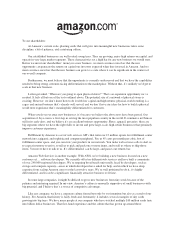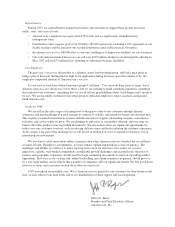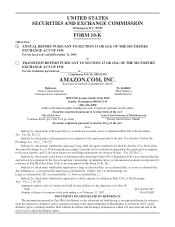Amazon.com 2006 Annual Report Download - page 3
Download and view the complete annual report
Please find page 3 of the 2006 Amazon.com annual report below. You can navigate through the pages in the report by either clicking on the pages listed below, or by using the keyword search tool below to find specific information within the annual report.
To our shareholders:
At Amazon’s current scale, planting seeds that will grow into meaningful new businesses takes some
discipline, a bit of patience, and a nurturing culture.
Our established businesses are well-rooted young trees. They are growing, enjoy high returns on capital, and
operate in very large market segments. These characteristics set a high bar for any new business we would start.
Before we invest our shareholders’ money in a new business, we must convince ourselves that the new
opportunity can generate the returns on capital our investors expected when they invested in Amazon. And we
must convince ourselves that the new business can grow to a scale where it can be significant in the context of
our overall company.
Furthermore, we must believe that the opportunity is currently underserved and that we have the capabilities
needed to bring strong customer-facing differentiation to the marketplace. Without that, it’s unlikely we’d get to
scale in that new business.
I often get asked, “When are you going to open physical stores?” That’s an expansion opportunity we’ve
resisted. It fails all but one of the tests outlined above. The potential size of a network of physical stores is
exciting. However: we don’t know how to do it with low capital and high returns; physical-world retailing is a
cagey and ancient business that’s already well served; and we don’t have any ideas for how to build a physical
world store experience that’s meaningfully differentiated for customers.
When you do see us enter new businesses, it’s because we believe the above tests have been passed. Our
acquisition of Joyo.com is a first step in serving the most populous country in the world. E-commerce in China is
still in its early days, and we believe it’s an excellent business opportunity. Shoes, apparel, groceries: these are
big segments where we have the right skills to invent and grow large-scale, high-return businesses that genuinely
improve customer experience.
Fulfillment by Amazon is a set of web services API’s that turns our 12 million square foot fulfillment center
network into a gigantic and sophisticated computer peripheral. Pay us 45 cents per month per cubic foot of
fulfillment center space, and you can stow your products in our network. You make web services calls to alert us
to expect inventory to arrive, to tell us to pick and pack one or more items, and to tell us where to ship those
items. You never have to talk to us. It’s differentiated, can be large, and passes our returns bar.
Amazon Web Services is another example. With AWS, we’re building a new business focused on a new
customer set … software developers. We currently offer ten different web services and have built a community
of over 240,000 registered developers. We’re targeting broad needs universally faced by developers, such as
storage and compute capacity—areas in which developers have asked for help, and in which we have deep
expertise from scaling Amazon.com over the last twelve years. We’re well positioned to do it, it’s highly
differentiated, and it can be a significant, financially attractive business over time.
In some large companies, it might be difficult to grow new businesses from tiny seeds because of the
patience and nurturing required. In my view, Amazon’s culture is unusually supportive of small businesses with
big potential, and I believe that’s a source of competitive advantage.
Like any company, we have a corporate culture formed not only by our intentions but also as a result of our
history. For Amazon, that history is fairly fresh and, fortunately, it includes several examples of tiny seeds
growing into big trees. We have many people at our company who have watched multiple $10 million seeds turn
into billion dollar businesses. That first-hand experience and the culture that has grown up around those
















